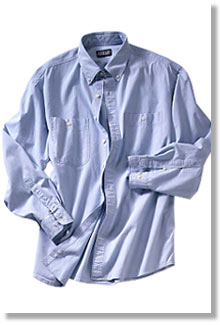Clothes and shoes! All
people who have been sent here to the online PPE training to choose and
complete the appropriate sections MUST complete this one. If your
work requires no other PPE, check the clothing checkbox only. If you
check only the clothing checkbox and submit, it will be taken to mean that
clothing and shoes are the only PPE required for your work.
 Covering on various parts of your skin is necessary depending on
the stipulations of your hazard assessment and standard operating procedures. For
general chemical and biological work, skin covering to wrists or to elbows is generally
required, depending on the quantities and hazards of the material(s). For work with
ultraviolet light Covering on various parts of your skin is necessary depending on
the stipulations of your hazard assessment and standard operating procedures. For
general chemical and biological work, skin covering to wrists or to elbows is generally
required, depending on the quantities and hazards of the material(s). For work with
ultraviolet light sources (some lasers, some
welding operations, some biological work) it is common for certain skin covering to be
stipulated in the hazard assessment or SOP. Fire-resistant material is recommended
for clothes worn for work around class 4 lasers or when welding. sources (some lasers, some
welding operations, some biological work) it is common for certain skin covering to be
stipulated in the hazard assessment or SOP. Fire-resistant material is recommended
for clothes worn for work around class 4 lasers or when welding.
 Except for
special equipment that would not consititute part of an individual's normal wear, e.g.,
boots with reinforced toes, the items refered to here as "other cover" are
regarded as personal, and they are to be provided by the employee. The extent of
coverage (to wrists, to throat, to knees or ankles) should conform with those stated in
the hazard assessment and the SOP. Nylon stockings do not qualify as protective
covering to ankles, nor do sheer tights. Clothes must not have holes, rips, or
snags which might catch on equipment or furniture, or which might catch fire more easily
than intact clothing. Certain operations (some welding, large quantities of
cryogens) require cuffless trousers; check the hazard assessment. Except for
special equipment that would not consititute part of an individual's normal wear, e.g.,
boots with reinforced toes, the items refered to here as "other cover" are
regarded as personal, and they are to be provided by the employee. The extent of
coverage (to wrists, to throat, to knees or ankles) should conform with those stated in
the hazard assessment and the SOP. Nylon stockings do not qualify as protective
covering to ankles, nor do sheer tights. Clothes must not have holes, rips, or
snags which might catch on equipment or furniture, or which might catch fire more easily
than intact clothing. Certain operations (some welding, large quantities of
cryogens) require cuffless trousers; check the hazard assessment.
 If the hazard assessment stipulates covering to throat, this means the If the hazard assessment stipulates covering to throat, this means the  shirt or blouse should come to the throat (above or at the
clavicles = collarbones); if the shirt has buttons they should be buttoned to this point, at
least. If the hazard assessment or SOP specifies covering to wrists, the wrists
should be covered, and any cuff buttons should be buttoned. Shoes should cover
the feet front, back, and top, and should be quickly removable. If the shoes have
laces they should be of such a design that spilled liquids will not penetrate easily or
quickly. Socks should be worn under shoes. For some welding operations it is
important that the worker's shirt be worn outside of the trousers (i.e. not
tucked into the trousers); this will be stipulated in the hazard assessment. shirt or blouse should come to the throat (above or at the
clavicles = collarbones); if the shirt has buttons they should be buttoned to this point, at
least. If the hazard assessment or SOP specifies covering to wrists, the wrists
should be covered, and any cuff buttons should be buttoned. Shoes should cover
the feet front, back, and top, and should be quickly removable. If the shoes have
laces they should be of such a design that spilled liquids will not penetrate easily or
quickly. Socks should be worn under shoes. For some welding operations it is
important that the worker's shirt be worn outside of the trousers (i.e. not
tucked into the trousers); this will be stipulated in the hazard assessment.
 Your
"street clothes" (your "normal," "daily wear," "other
cover") is only appropriate and sufficient if it is what's required by the hazard
assessment(s) which apply to the work in which you're engaged. Furthermore, your
employer does not replace ruined clothes or shoes that could have been protected by the
use of further outer-wear such as lab coat, apron, or in extreme cases, coveralls or a
chemically resistant suit. Your
"street clothes" (your "normal," "daily wear," "other
cover") is only appropriate and sufficient if it is what's required by the hazard
assessment(s) which apply to the work in which you're engaged. Furthermore, your
employer does not replace ruined clothes or shoes that could have been protected by the
use of further outer-wear such as lab coat, apron, or in extreme cases, coveralls or a
chemically resistant suit.
 Nothing
that has been contaminated with hazardous materials should be taken home for
cleaning. This includes your clothes and shoes. If/when they become
contaminated with hazardous materials they should be Nothing
that has been contaminated with hazardous materials should be taken home for
cleaning. This includes your clothes and shoes. If/when they become
contaminated with hazardous materials they should be |
 sources (some lasers, some
welding operations, some biological work) it is common for certain skin covering to be
stipulated in the hazard assessment or SOP. Fire-resistant material is recommended
for clothes worn for work around class 4 lasers or when welding.
sources (some lasers, some
welding operations, some biological work) it is common for certain skin covering to be
stipulated in the hazard assessment or SOP. Fire-resistant material is recommended
for clothes worn for work around class 4 lasers or when welding. shirt or blouse should come to the throat (above or at the
clavicles = collarbones); if the shirt has buttons they should be buttoned to this point, at
least. If the hazard assessment or SOP specifies covering to wrists, the wrists
should be covered, and any cuff buttons should be buttoned. Shoes should cover
the feet front, back, and top, and should be quickly removable. If the shoes have
laces they should be of such a design that spilled liquids will not penetrate easily or
quickly. Socks should be worn under shoes. For some welding operations it is
important that the worker's shirt be worn outside of the trousers (i.e. not
tucked into the trousers); this will be stipulated in the hazard assessment.
shirt or blouse should come to the throat (above or at the
clavicles = collarbones); if the shirt has buttons they should be buttoned to this point, at
least. If the hazard assessment or SOP specifies covering to wrists, the wrists
should be covered, and any cuff buttons should be buttoned. Shoes should cover
the feet front, back, and top, and should be quickly removable. If the shoes have
laces they should be of such a design that spilled liquids will not penetrate easily or
quickly. Socks should be worn under shoes. For some welding operations it is
important that the worker's shirt be worn outside of the trousers (i.e. not
tucked into the trousers); this will be stipulated in the hazard assessment. If your shoes and/or clothes become so grossly contaminated with
hazardous material as to qualify as hazardous waste, and you cannot or choose not to clean
them, they must be disposed of as hazardous waste. (This is a difficult call to make
sometimes; the criteria for identifying a waste as hazardous waste will seem a bit odd to
the unfamiliar. See "when is a waste a hazardous
waste?" or phone the REM hazMat section at 40121 for assistance.) Items
which are contaminated with biologically hazardous matierals, and which you cannot or do
not wish to clean, should go into the biowaste.
If your shoes and/or clothes become so grossly contaminated with
hazardous material as to qualify as hazardous waste, and you cannot or choose not to clean
them, they must be disposed of as hazardous waste. (This is a difficult call to make
sometimes; the criteria for identifying a waste as hazardous waste will seem a bit odd to
the unfamiliar. See "when is a waste a hazardous
waste?" or phone the REM hazMat section at 40121 for assistance.) Items
which are contaminated with biologically hazardous matierals, and which you cannot or do
not wish to clean, should go into the biowaste.